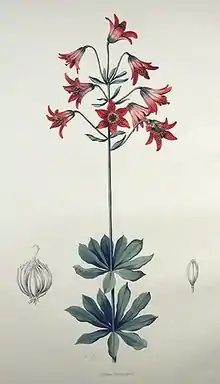| Lilium bolanderi | |
|---|---|
 | |
| 1877 illustration[1] | |
| Scientific classification | |
| Kingdom: | Plantae |
| Clade: | Tracheophytes |
| Clade: | Angiosperms |
| Clade: | Monocots |
| Order: | Liliales |
| Family: | Liliaceae |
| Subfamily: | Lilioideae |
| Tribe: | Lilieae |
| Genus: | Lilium |
| Species: | L. bolanderi |
| Binomial name | |
| Lilium bolanderi | |
| Synonyms[2] | |
| |
Lilium bolanderi is a rare North American species of plants in the lily family, known by the common name Bolander's lily. It is native to northwestern California (Del Norte, Humboldt, & Siskiyou Counties) and southwestern Oregon (Curry + Josephine Counties).[2][3][4]
Lilium bolanderi is a perennial herb growing a waxy, erect stem that approaches a meter in height. It originates from a scaly, elongated bulb up to about 7 centimeters long. The wavy oval leaves are located in several whorls about the stem, each waxy green and up to 7 centimeters in length. The inflorescence bears up to 9 large, nodding lily flowers. The flower is bell-shaped with 6 red tepals up to 5 centimeters long and marked with yellow, purple, or darker reds. It often hybridizes with other lilies, producing a variety of forms, colors and patterns. There are 6 stamens with anthers sometimes nearly a centimeter long and a pistil which may be 4 centimeters in length. The flowers are pollinated by Allen's and rufous hummingbirds, Selasphorus sasin and rufus, respectively.[3]
The lily was named after the California botanist Henry Nicholas Bolander.
References
- ↑ handcolored Lithography by Henry John Elwes (1846-1922)
- 1 2 "Plants of the World Online | Kew Science". Plants of the World Online. Retrieved 2023-05-15.
- 1 2 "Lilium bolanderi in Flora of North America @ efloras.org". www.efloras.org. Retrieved 2023-05-15.
- ↑ Biota of North America Program 2014 county distribution map
External links